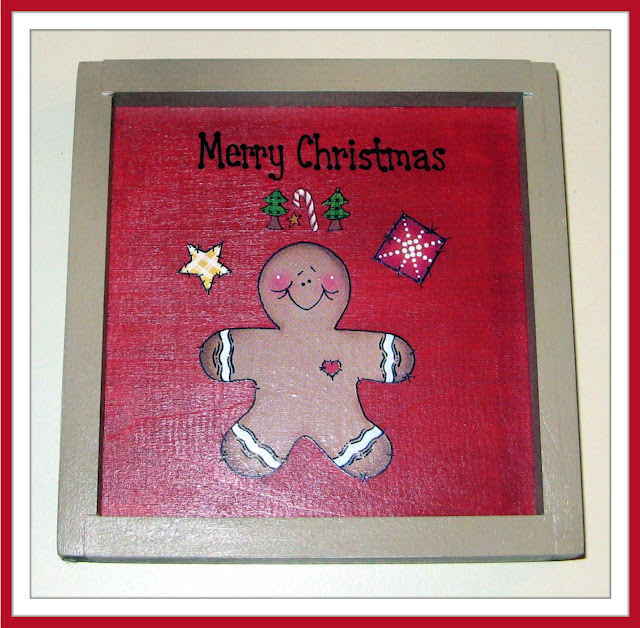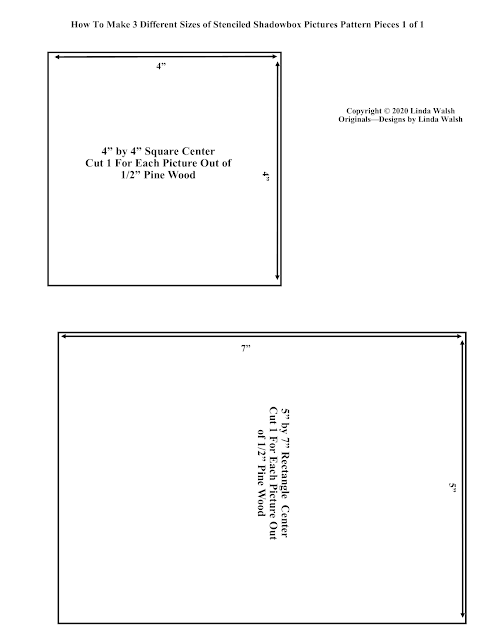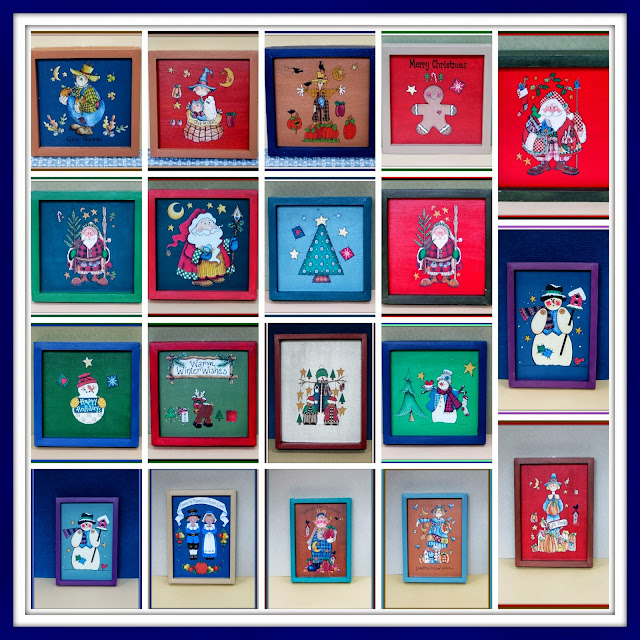
I just love seasonal and holiday shadowboxes and have made many over the years. Some were decorations, some were given as gifts and some have been for sale.

The shadowboxes I made were mostly made out of 1/2"x 1" pine for the frames and 1/2" pine boards for the centers. The centers were two different sizes: 4” by 4” and 5” by 7” wood pieces.

The frames were cut from the wood and were painted one color and the center boards were painted another. The finished shadowboxes ended up being 5” by 5” and 6” by 8” when framed.
The pictures were created by adding rub-on stencils to the center boards to complete the pictures.

There was only one exception to the wood pictures I made and that was for the snowman picture shown in the top left corner of the collage above and in the picture to the right. That shadowbox was created using pine wood for the frames and a 8"x 10" stretched canvas board for the enter.
The finished picture measured 9” by 11” when framed.
Like the other shadowbox pictures I painted the canvas panel a different color than the wood frames and then applied the rub-on stencils that I had purchased at various arts & crafts stores to create the picture.
Brush on varnish was added to seal everything.
In 1999 I ended up making twenty-four 5” by 5” shadowbox pictures, eight 6” by 8” shadowbox pictures, and two 9” by 11” shadowbox pictures.
I made shadowbox pictures for Christmas holiday decorations, fall seasonal decorations, winter seasonal decorations, and Halloween decorations. I ended up giving over half of them away as Christmas presents that year.
That is generally how I made them.
Here’s exactly how I made them:
Supplies Needed
1/2” by 1” Pine Wood - For Wood Frames (2 Feet Long for Each 5” by 5” Picture)
1/2” by 1” Pine Wood - For Wood Frames (3 Feet” Long for Each 6” by 8” Picture)
1/2” by 1” Pine Wood - For Wood Frames (4 Feet” Long for Each 9” by 11” Picture)
1/2” Pine Wood - For Wood Centers (1/2” by 7” by 7” for Each 5” by 5” Picture)
1/2” Pine Wood - For Wood Centers (1/2” by 8” by 10” for Each 6” by 8” Picture)
Determine how many shadowbox pictures you will be making for each size picture and then adjust the amount of wood you will need to buy for the frames and for the centers.
8” by 10” Stretched Canvas Boards - One For Each 9” by 11” Shadowbox Picture
Rub-On Stencils or Transfers With Popsicle Sticks
Acrylic Paints
Pencil
Varnish
Paint Brushes
Thin Nails - 3/4” Long
Thin Nails - 1” Long
Mitre Saw or Table Saw
Sandpaper
Hammer
Saw Tooth Hanger - 1 For Each Picture
Paper Towel
Instructions For 5" by 5" Shadowbox Picture:
The shadowboxes may be different sizes but they are basically made the same way so follow the directions below for the 5” by 5” shadowbox just changing the wood needed for the 6” by 8” picture and 9” by 11” stretched canvas board wood frame.

1) Use the pattern piece as a guide for the 5” by 5” picture and lightly draw a 4” by 4” square on the 1/2” pine wood with the pencil. Do the same for the 6” by 8” picture and it’s respective pattern piece.

Pictures of the pattern piece sheet is shown above. For full size pattern piece sheets please CLICK HERE to download the full size pattern piece sheets for all twelve of the leaves from my free How To Make 3 Sizes of Stenciled Shadowbox Pictures - Linda's How-Do-I Series? e-book.
2) Cut the wood piece for the 4” by 4” square center out of the 1/2” pine wood using the mitre saw or table saw.
3) Use the sandpaper to lightly sand the front and back of the wood piece, then wipe clean with a damp paper towel and let it dry.
4) Cut the four wood pieces for the frame out using the mitre saw or table saw.
5) Cut two 5” long pieces out of the 1 2/” by 1” pine wood, then wipe clean with a damp paper towel and let each piece dry.
6) Cut two 4” long pieces out of the 4” by 1” pine wood, then wipe clean with a damp paper towel and let each piece dry.
7) Use the sandpaper to lightly sand the wood pieces, then wipe clean with a damp paper towel and let it dry.

8) Position the end of one of the 5” long pine wood pieces to the end of one of the 4” long pine wood pieces, as shown in Diagram #1.
9) Nail two of the 1” long thin nails to the end of the 5” long piece spacing them evenly at the end about 1/4” from the edge, as shown in Diagram #1.

10) Position the end of the other 5” long pine wood pieces to the other end of the 4” long pine wood piece, as shown in Diagram #2.
11) Nail two of the 1” long thin nails to the end of the 5” long piece spacing them evenly at the end about 1/4” from the edge, as shown in Diagram #2.

12) Position the end of the remaining 4” long pine wood piece in between the two 5” long pieces so the ends all match, as shown in Diagram #3.
13) Nail two of the 1” long thin nails to both of the ends of each of the 5” long pieces spacing them evenly at the end about 1/4” from the edge, as shown in Diagram #3.

14) Place the 4” square wood center piece inside the 5” by 5” wood frame so all four sides are flush with the back of the wood frame leaving a 1/2” shadowbox lip on the front of the frame, as shown in diagram #4.
15) Now you want to insert the center square and nail it to the wood frame. Nail three of the 3/4” long thin nails to each of the four sides spacing them evenly between the length of the 4” center square along each of the sides of the frame about 1/4” from the center square edge and frame bottom edge, as shown in Diagram #4.

16) Paint the front and back of the 4” by 4” center with the acrylic color you’ve chosen for this picture and let the paint dry, as shown in Diagram #5.
17) Paint all the sides of the 5” by 5” frame with the acrylic color or colors you have chosen for this picture and let the paints dry, as shown in Diagram #5.

18) Place the rub-on stencils that you want for the picture on the front of the 4” by 4” center piece and then rub them on with the popsicle stick following the directions for the stencil you bought, as shown in Diagram #6.
19) When your stencil is securely positioned on the center piece apply the varnish to the entire picture with the paintbrush and let it dry, as shown in Diagram #6.
20) When your picture is dry apply the sawtooth picture hanger to the center back of the top of the frame and hang your stenciled shadowbox picture on a wall.

For the 6” by 8” shadowbox picture follow the directions for the 5” by 5” shadowbox picture Step #1 through Step #20 except change the dimensions of the center rectangle and the length of the sides of the frame.

For the 9” by 11” shadowbox picture follow Step #4 through Step #13 for creating the frame. For Step #14 through Step #20 paint the 8” by 10” stretched canvas board first before inserting it into the wood frame in Step#14.
Congratulations! Your three different size shadowbox pictures are done. Enjoy!
I also created a free e-book for you showing how I made my three sizes of stenciled shadowbox pictures.

To view and download my free e-book please CLICK HERE. You'll be brought to Google Drive where you can view my free e-book. Then just download my free .pdf e-book by clicking on the down arrow in the top center.
For more information on all my free e-patterns, e-printables and e-books please CLICK HERE.
Please respect My Terms of Use: All patterns, e-patterns, printables, e-printables, e-books, graphics, tutorials, how-to's, articles and other e-products © 2004-2023 Linda Walsh Originals-Designs by Linda Walsh. All rights reserved. Commercial selling or reselling by any means prohibited without the written consent of Linda Walsh.
Patterns, e-patterns, printables, e-printables, e-books, graphics, tutorials, how-to's, articles and other e-products are for personal use only. You may not modify, photocopy, download, upload, post, transmit, display, perform, publish, license, reprint, create derivative works from, mass duplicate, re-sell, digitize, and reproduce in any other form (print, digital or electric) or commercially apply, embed, share, Email, or redistribution in any other means. Use of any of the above is prohibited without the written permission of Linda Walsh.
Patterns, e-patterns, printables, e-printables, e-books, graphics, tutorials, how-to's, articles and other e-products are for personal use only. You may not modify, photocopy, download, upload, post, transmit, display, perform, publish, license, reprint, create derivative works from, mass duplicate, re-sell, digitize, and reproduce in any other form (print, digital or electric) or commercially apply, embed, share, Email, or redistribution in any other means. Use of any of the above is prohibited without the written permission of Linda Walsh.
However, you may link to my website(s)/blog(s) and the individual page(s)/blog post(s) (including 1 picture) but do not copy, reprint or duplicate my website(s)/blog(s) or individual page(s)/post(s ) without my permission.
Items made from Linda Walsh Originals E-Patterns are intended for personal use for fun or small scale personal and business profit as long as you credit us with the design. Large scale commercial use (i.e. mass production) of items made from Linda Walsh Originals E-Patterns are by permission only.
Please see my Terms and Conditions for additional information.
Copyright © 2004 - 2023 - All Rights Reserved - Written By Linda Walsh of Linda Walsh Originals and Linda's Blog. Linda is a doll maker and doll pattern designer.














































